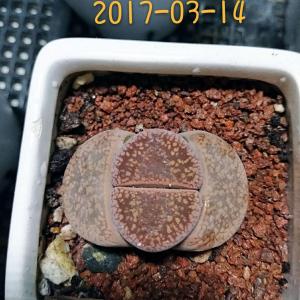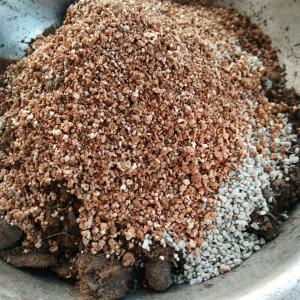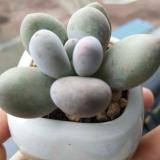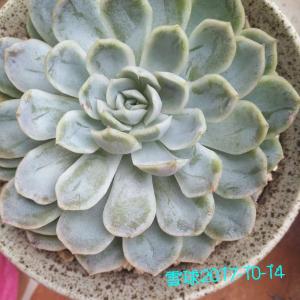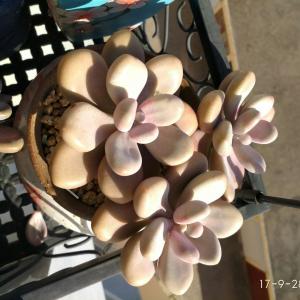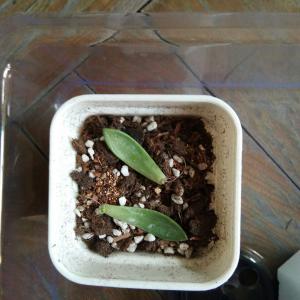文章
Miss Chen
2017年12月18日

Description: This perennial plant consists of a rosette of basal leaves up to 1½' across and one or more flowering stalks up to 2½' tall. The strap-shaped basal leaves are up to 14" long and 1" across; they are linear, smooth along the margins, and glabrous. Their veins are parallel. These basal leaves are rather floppy and they often arch downward or sprawl across the ground in the absence of support from other vegetation. The basal leaves wither away by mid-summer. The flowering stalks are erect, slender, hairless, and leafless. Each stalk terminates in a raceme of about 20-80 flowers. Each flower consists of 6 lavender to pale blue-violet tepals, 6 stamens with golden yellow anthers, and a light green pistil with a short slender style. Each flower spans about ¾" across when it is fully open. The pedicels of the flowers are slender, green, and deciduous, unless the flower is successfully cross-pollinated. Underneath each flower, there is often a persistent bract about ¾" long that is thread-like in appearance. After the flowers begin blooming on the raceme, there can be 3-20 (or more) of these bracts underneath. Several flowers bloom in a ring at the same time, which forms at the bottom of the raceme and moves upward. The blooming period occurs from late spring to early summer and can last up to 1 month for a colony of plants. The flowers that are successfully cross-pollinated form seed capsules that are ovoid-oblongoid in shape. Each capsule contains several seeds. The root system consists of a bulb with secondary fibrous roots at the bottom. This plant reproduces by forming offsets from the bulbs and by reseeding itself.
Cultivation: The preference is full or partial sun, moist to mesic conditions, and a fertile loamy soil. This plant is rarely bothered by disease and insect pests. It is somewhat slow to develop, especially from seeds.
Range & Habitat: In Illinois, Prairie Hyacinth is a rare plant that has been observed in Macon and Peoria counties only (see Distribution Map). At the present time, only one population of plants is known to exist within the state at a railroad prairie. Apparently, the other population has been extirpated. In neighboring states, Prairie Hyacinth has been observed in prairies and thinly-wooded areas. This native species is state-listed as 'endangered' in Illinois.
Faunal Associations: The flowers attract both long-tongued and short-tongued bees, which suck nectar or collect pollen. Other visitors of the flowers include various flies, butterflies, skippers, wasps, and beetles, which suck nectar or feed on pollen. Aside from these flower-visiting insects, little information is available about floral-faunal relations for this wildflower.

Photographic Location: The webmaster's wildflower garden in Urbana, Illinois.
Comments: This little-known species is sometimes confused with Camassia scilloides (Wild Hyacinth), which is more common within the state. Both species are attractive wildflowers with similar habitat preferences. Their appearance is quite similar, which can make them difficult to tell apart. Prairie Hyacinth begins to flower about a month later than Wild Hyacinth and there is little overlap in their blooming periods; this is one good reason why they should be considered separate species. The flowering stalk of Prairie Hyacinth has 3-20 (or more) persistent bracts underneath the blooming flowers, while Wild Hyacinth has 0-2 deciduous bracts underneath the flowers of its stalks. The seed capsules of Prairie Hyacinth are longer than they are wide, while the seed capsules of Wild Hyacinth are about as long as they are wide. The flowers of Prairie Hyacinth tend to have shorter styles, shorter stamens, and tepals that are a little shorter and more deeply colored, but these distinctions are less reliable, or they require the careful use of a ruler or measuring tape in the field.
Cultivation: The preference is full or partial sun, moist to mesic conditions, and a fertile loamy soil. This plant is rarely bothered by disease and insect pests. It is somewhat slow to develop, especially from seeds.
Range & Habitat: In Illinois, Prairie Hyacinth is a rare plant that has been observed in Macon and Peoria counties only (see Distribution Map). At the present time, only one population of plants is known to exist within the state at a railroad prairie. Apparently, the other population has been extirpated. In neighboring states, Prairie Hyacinth has been observed in prairies and thinly-wooded areas. This native species is state-listed as 'endangered' in Illinois.
Faunal Associations: The flowers attract both long-tongued and short-tongued bees, which suck nectar or collect pollen. Other visitors of the flowers include various flies, butterflies, skippers, wasps, and beetles, which suck nectar or feed on pollen. Aside from these flower-visiting insects, little information is available about floral-faunal relations for this wildflower.

Photographic Location: The webmaster's wildflower garden in Urbana, Illinois.
Comments: This little-known species is sometimes confused with Camassia scilloides (Wild Hyacinth), which is more common within the state. Both species are attractive wildflowers with similar habitat preferences. Their appearance is quite similar, which can make them difficult to tell apart. Prairie Hyacinth begins to flower about a month later than Wild Hyacinth and there is little overlap in their blooming periods; this is one good reason why they should be considered separate species. The flowering stalk of Prairie Hyacinth has 3-20 (or more) persistent bracts underneath the blooming flowers, while Wild Hyacinth has 0-2 deciduous bracts underneath the flowers of its stalks. The seed capsules of Prairie Hyacinth are longer than they are wide, while the seed capsules of Wild Hyacinth are about as long as they are wide. The flowers of Prairie Hyacinth tend to have shorter styles, shorter stamens, and tepals that are a little shorter and more deeply colored, but these distinctions are less reliable, or they require the careful use of a ruler or measuring tape in the field.
0
0
文章
Dummer. ゛☀
2017年09月20日

The genus Tavaresia includes at least 2 species (Tavaresia barklyi, Tavaresia angolensis) of spiny stem succulents native to southern Africa. Short, erect, 6-14 angled stems carry rows of tubercles furnished with 3 fine white spines which gives the plants a cactoid appearance. Technically, these spines represent a modified leaf spine with 2 side stipules, unique to this genus. Stems take on a dramatic dark colouration in a sunny position, contrasting with the spines. The large funnel-shaped flowers make these plants attractive to collectors. Swellings near the tips of the coronal lobes are also unique to this genus.
Growing Conditions
Light: Tavaresias prefer light shade rather than full sun, although stems may not color up under shady conditions.
Water: They should at all times sparingly watered (best rain water with some occasional fertilizer), and in winter time they hardly require any.
Temperature: A minimum winter temperature of 41°F (5°C) is acceptable, providing that plants are kept absolutely dry.
Soil: They grow well in light gritty soil with a very liberal drainage.
General Care
Tavaresias are mainly grown by plant collectors, lovers of succulents and enthusiasts who enjoy growing unorthodox looking plants. They comes from summer rainfall areas, and are intolerant of excess water, humidity and low winter temperatures and easily destroyed by molds. Flower buds drop off easily in response to the slightest touch or unfavorable conditions.
Propagation
Plants are usually increased by cuttings, which, as they are very succulent, should be allowed to dry a week after they are taken off, when they may at once be put singly into pots. Grafting the Tavaresia on Stapelias is often useful, and can be recommended.
Pest and Problems
Keep their roots free of mealy bugs, as fungal attack often occurs as a result of damage to stems by insects. A layer of grit on the surface of the compost prevents moisture from accumulating around the base of the stems and minimize the chance of fungal attack on the roots.

Growing Conditions
Light: Tavaresias prefer light shade rather than full sun, although stems may not color up under shady conditions.
Water: They should at all times sparingly watered (best rain water with some occasional fertilizer), and in winter time they hardly require any.
Temperature: A minimum winter temperature of 41°F (5°C) is acceptable, providing that plants are kept absolutely dry.
Soil: They grow well in light gritty soil with a very liberal drainage.

General Care
Tavaresias are mainly grown by plant collectors, lovers of succulents and enthusiasts who enjoy growing unorthodox looking plants. They comes from summer rainfall areas, and are intolerant of excess water, humidity and low winter temperatures and easily destroyed by molds. Flower buds drop off easily in response to the slightest touch or unfavorable conditions.

Propagation
Plants are usually increased by cuttings, which, as they are very succulent, should be allowed to dry a week after they are taken off, when they may at once be put singly into pots. Grafting the Tavaresia on Stapelias is often useful, and can be recommended.

Pest and Problems
Keep their roots free of mealy bugs, as fungal attack often occurs as a result of damage to stems by insects. A layer of grit on the surface of the compost prevents moisture from accumulating around the base of the stems and minimize the chance of fungal attack on the roots.
0
0
文章
Miss Chen
2017年09月20日

Las azucenas o lirios, Lilium spp, son unas fantásticas plantas ornamentales gracias a su floración. Son también una flor de corte de importancia trascendental. Con estas 14 variedades de azucenas que os mostramos a continuación esperamos que tengáis material suficiente para una primera elección. Es una pequeña muestra pues hay como un centenar de especies de Lilium con sus consabidos cultivares, en definitiva mucho donde escoger.

Primero aclarar un pequeño detalle técnico, aunque hay muchas plantas que reciben el nombre de lirios o se las considera como tales hay que saber que lirios o azucenas sólo lo son las que pertenecen al género Lilium. Así las calas y los lirios de días, aunque se les llame lirios y se las trate como tales pertenecen a otros géneros botánicos. Todas las especies que veremos a continuación son azucenas y son Lilium.
Las azucenas se plantan la mayoría en primavera y algunas especies, pocas, en otoño. Una vez plantadas florecerán durante un par de años. Necesitan sombra parcial y temperaturas frescas por eso se suelen cultivar debajo de los árboles. Cada 3-4 años se entresacan los bulbos y se replantan para conseguir nuevos ejemplares.
Lilium Stargazer

El Lilium ‘Stargazer’ es un híbrido de Lilium orientalis desarrollado en la decada de los 70, como muchos otros. Alcanza una altura de unos 90 cm y es una azucena muy perfumada.
Lilium Casablanca

El Lilium ‘Casablanca’ es otra azucena del conocido como grupo oriental, o sea que descienden o derivan de la Lilium orientalis. Destaca por su blancura absoluta y es muy utilizada en ramos nupciales.
Lilium Mrs R.O. Backhouse

Lilium ‘Mrs R.O. Backhouse’ es una azucena vigorosa y fácil de cultivar. Su floración amarillo-anaranjada se presenta en racimos distribuidos en forma piramidal. Es una variedad que tolera mejor la sombra que el resto de las azucenas. Se plantan en otoño y necesitan buen drenaje. Su crecimiento es algo lento y no florecerá hasta su segunda primavera.
Lilium Tiny Bee

Lilium ‘Tiny Bee’ es un cultivar de Lilium orientalis desarrollado en Holanda para cultivo en maceta. Es una azucena de bajo porte, 30-35 cm de altura, y muy adaptable a suelos y condiciones lumínicas. Florece a mediados del verano.
Lilium Lollipop

El bonito colorido del Lilium ‘Lollipop’ hace que sea una flor especialmente indicada para borduras y macetas. También es de pequeño porte, unos 35 cm de altura, y se ha de plantar a pleno sol o en sombra parcial. Se siembra en otoño y florece en verano. El suelo debe ser fértil y bien drenado.
Lilium lancifolium

El lirio tigre, Lilium lancifolium, es muy alto, sobre 120 cm de altura, y muy vigoroso. Una buena elección para iniciarse en el cultivo de las azucenas. Crece mejor en suelos neutros o ligeramente alcalinos y de textura arenosa o arcillosa. Necesita tener siempre el suelo húmedo pero no tolera en absoluto el encharcamiento. Lo plantaremos a pleno sol o en sombra parcial.
Lilium longiflorum

La azucena blanca o lirio de Pascua, Lilium longiflorum, también es un ejemplar de notable altura que puede llegar hasta los 125 cm. Sol y un suelo bien drenado son sus necesidades básicas. Florece naturalmente a finales de verano. Comercialmente se fuerza su floración en muchos países para su consumo como flor cortada típica de la Pascua.
Lilium regale

Lilium regale es originaria del sudoeste de China. Es muy adaptable y de fácil cultivo. Alcanza una altura de 90-120 cm y crece bien a pleno sol. El suelo debe mantenerse siempre húmedo pero contando con buen drenaje.
Lilium orientalis

La azucena ‘Acapulco’ es otro híbrido de Lilium orientalis y destaca por su coloración rosada y su fragante aroma. Alcanza también una buena altura, 90-120 cm y necesita suelos neutros o ligeramente ácidos.
Lilium Elody

Lilium ‘Elody’ es también un híbrido oriental que ha tenido un gran éxito como flor de corte al no contar éstas con polen. Su pequeña altura, unos 50 cm, la hace una variedad idónea para el cultivo en maceta.
Lilium Robert Swanson

Lilium ‘Robert Swanson’ es un lirio oriental de grandes flores amarillas o anaranjadas. Necesita al menos 6 horas de sol directo y aúna las virtudes de los lirios orientales, la fragancia y la resistencia, con el buen rendimiento de los lirios trompeta.
Lilium Luxor

Lilium ‘Luxor’ es un híbrido oriental de unos 90-120 cm de altura. Se adapta a suelos que van desde ligeramente alcalinos hasta ácidos. Se reproduce por bulbos o división de la mata y por semillas en otoño. Necesitará sol o sombra parcial.
Azucena Tiny Double You

La azucena ‘Tiny Double You’ es un híbrido oriental enano, 30-45 cm de altura. Se ha de cultivar a pleno sol y en suelos neutros o ligeramente ácidos. Sus flores son muy atractivas para las abejas y las mariposas. Son de color anaranjado y fragantes. Muy recomendable para cultivo en maceta.
Lirio Matrix

El lirio ‘Matrix’ es un híbrido asiático que alcanza una altura de 40-50 cm. Produce hasta siete flores por tallo y es ideal para cultivo en fronteras y macetas. Florece a principios del verano y resulta muy atractivo para las mariposas. Es una excelente flor de corte.

Primero aclarar un pequeño detalle técnico, aunque hay muchas plantas que reciben el nombre de lirios o se las considera como tales hay que saber que lirios o azucenas sólo lo son las que pertenecen al género Lilium. Así las calas y los lirios de días, aunque se les llame lirios y se las trate como tales pertenecen a otros géneros botánicos. Todas las especies que veremos a continuación son azucenas y son Lilium.
Las azucenas se plantan la mayoría en primavera y algunas especies, pocas, en otoño. Una vez plantadas florecerán durante un par de años. Necesitan sombra parcial y temperaturas frescas por eso se suelen cultivar debajo de los árboles. Cada 3-4 años se entresacan los bulbos y se replantan para conseguir nuevos ejemplares.
Lilium Stargazer

El Lilium ‘Stargazer’ es un híbrido de Lilium orientalis desarrollado en la decada de los 70, como muchos otros. Alcanza una altura de unos 90 cm y es una azucena muy perfumada.
Lilium Casablanca

El Lilium ‘Casablanca’ es otra azucena del conocido como grupo oriental, o sea que descienden o derivan de la Lilium orientalis. Destaca por su blancura absoluta y es muy utilizada en ramos nupciales.
Lilium Mrs R.O. Backhouse

Lilium ‘Mrs R.O. Backhouse’ es una azucena vigorosa y fácil de cultivar. Su floración amarillo-anaranjada se presenta en racimos distribuidos en forma piramidal. Es una variedad que tolera mejor la sombra que el resto de las azucenas. Se plantan en otoño y necesitan buen drenaje. Su crecimiento es algo lento y no florecerá hasta su segunda primavera.
Lilium Tiny Bee

Lilium ‘Tiny Bee’ es un cultivar de Lilium orientalis desarrollado en Holanda para cultivo en maceta. Es una azucena de bajo porte, 30-35 cm de altura, y muy adaptable a suelos y condiciones lumínicas. Florece a mediados del verano.
Lilium Lollipop

El bonito colorido del Lilium ‘Lollipop’ hace que sea una flor especialmente indicada para borduras y macetas. También es de pequeño porte, unos 35 cm de altura, y se ha de plantar a pleno sol o en sombra parcial. Se siembra en otoño y florece en verano. El suelo debe ser fértil y bien drenado.
Lilium lancifolium

El lirio tigre, Lilium lancifolium, es muy alto, sobre 120 cm de altura, y muy vigoroso. Una buena elección para iniciarse en el cultivo de las azucenas. Crece mejor en suelos neutros o ligeramente alcalinos y de textura arenosa o arcillosa. Necesita tener siempre el suelo húmedo pero no tolera en absoluto el encharcamiento. Lo plantaremos a pleno sol o en sombra parcial.
Lilium longiflorum

La azucena blanca o lirio de Pascua, Lilium longiflorum, también es un ejemplar de notable altura que puede llegar hasta los 125 cm. Sol y un suelo bien drenado son sus necesidades básicas. Florece naturalmente a finales de verano. Comercialmente se fuerza su floración en muchos países para su consumo como flor cortada típica de la Pascua.
Lilium regale

Lilium regale es originaria del sudoeste de China. Es muy adaptable y de fácil cultivo. Alcanza una altura de 90-120 cm y crece bien a pleno sol. El suelo debe mantenerse siempre húmedo pero contando con buen drenaje.
Lilium orientalis

La azucena ‘Acapulco’ es otro híbrido de Lilium orientalis y destaca por su coloración rosada y su fragante aroma. Alcanza también una buena altura, 90-120 cm y necesita suelos neutros o ligeramente ácidos.
Lilium Elody

Lilium ‘Elody’ es también un híbrido oriental que ha tenido un gran éxito como flor de corte al no contar éstas con polen. Su pequeña altura, unos 50 cm, la hace una variedad idónea para el cultivo en maceta.
Lilium Robert Swanson

Lilium ‘Robert Swanson’ es un lirio oriental de grandes flores amarillas o anaranjadas. Necesita al menos 6 horas de sol directo y aúna las virtudes de los lirios orientales, la fragancia y la resistencia, con el buen rendimiento de los lirios trompeta.
Lilium Luxor

Lilium ‘Luxor’ es un híbrido oriental de unos 90-120 cm de altura. Se adapta a suelos que van desde ligeramente alcalinos hasta ácidos. Se reproduce por bulbos o división de la mata y por semillas en otoño. Necesitará sol o sombra parcial.
Azucena Tiny Double You

La azucena ‘Tiny Double You’ es un híbrido oriental enano, 30-45 cm de altura. Se ha de cultivar a pleno sol y en suelos neutros o ligeramente ácidos. Sus flores son muy atractivas para las abejas y las mariposas. Son de color anaranjado y fragantes. Muy recomendable para cultivo en maceta.
Lirio Matrix

El lirio ‘Matrix’ es un híbrido asiático que alcanza una altura de 40-50 cm. Produce hasta siete flores por tallo y es ideal para cultivo en fronteras y macetas. Florece a principios del verano y resulta muy atractivo para las mariposas. Es una excelente flor de corte.
0
0



